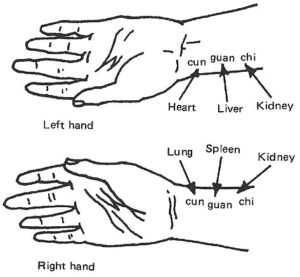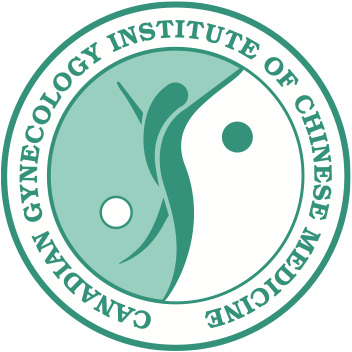The pulse reflects more than the Heart in Chinese Medicine.
In Chinese Medicine there are four methods of diagnosis:
- Inspection: facial complexion, body appearance, eyes, skin, hair, nails, tongue, etc.
- Listening & Smelling: sound of the voice and breath, etc.
- Inquiry: body temperature, sweating, appetite, thirst, body symptoms, bowel movements, menstrual cycle, etc.
- Palpation: pulse, area of pain, meridians of the body, etc.
Of these, the two that spark the most interest are the inspection of the tongue and palpation of the pulse. Let’s take a more in depth look at why Chinese Medicine examines the pulse.
Why Take the Pulse?
The pulse is taken to identify the inner workings of the body, which is unique to each person. This allows us to better diagnose any conditions. Through working on a constitutional basis with each person, treatment is often more effective. The change in the pulse indicates a progression of a condition, and by taking the pulse, TCM acupuncturists and practitioners are able to follow the disease course by following its progression, thus they are able to predict the outcome of the disease.
Where is the Pulse Taken?
There are different areas on the body where the pulse is taken such as the carotid artery in the neck (ST 9), the dorsal artery of the foot (ST 42), and the radial artery pulse. The radial artery pulse is by far the most common pulse examined.
Why the Radial Artery?
The radial artery shows the functioning of all of the organs in the body, both the Zang and the Fu. The radial artery passes through the hand Tai Yin (Lung) meridian of the body, and this meridian is where Qi and Blood accumulate and the Qi cycle through body begins – where all 12 channels meet, making this the area of manifestation of all functions in the body. Also, the Lung meridian starts in the Middle Jiao, also where the Spleen and Stomach (acquired essence) are located. This proximity makes communication easy between the Spleen, Stomach and Lung, thus the condition of the Qi and Blood are shown in the Lung meridian. The Classic, Basic Questions, Chapter 11 states: “How is it that the radial artery can reflect the five zang’s condition? Because the Stomach is the sea of food and water and the source of the six fu. The five tastes enter the mouth and are stored in the Stomach to nourish the five zang. The radial artery also pertains to Tai Yin, which begins in the middle burner, thus the condition of the five zang fu can be shown in the radial artery.”
How is the Pulse Taken?
The practitioner takes the pulse at three different positions on the wrist. An overall impression of the pulse is observed as well as the functioning of the internal organs, each with a different position on the wrist. There are varying concepts on pulse diagnosis, but the following description is the one most often used. On the left side is the Heart and Pericardium (distal position), Liver and Diaphragm (medial position), and Kidney and Lower Jiao (proximal position). On the right side is the Lung and Upper Jiao (distal position), Spleen-Stomach and Middle Jiao (medial position), and the Kidney, gate of vitality and Lower Jiao (proximal position). You might notice that the Kidney is represented on both sides, this is because the right pulse indicates Kidney Yang and the left pulse indicates Kidney Yin.

The pulse is also taken at different depths, meaning the practitioner pushes to feel the pulse at different layers, indicating the depth of the condition in the body, whether it is superficial or has penetrated deeply.
What does the Pulse Tell You?
A normal pulse is even, gentle, calm and palpable on all three positions and all three depths. It beats approximately 4-5 times per practitioner breath – or about 60-90 beats per minute. Generally, there are three basic things the pulse tells us, which all relate to diagnosis and prognosis of a disease or state.
- Stomach Qi: this refers to the digestive and metabolic functions of the body. It tells us how well the Stomach and Spleen are transforming what we eat and drink into the useful materials the body needs such as Qi and Blood.
- Shen: the Shen – or Spirit is largely related to the Heart organ in Chinese Medicine. The Spirit shows a person’s vitality and life force. Not only does this indicate the health of the Qi and Blood, but Essence as well.
- Rooting: this idea is highly related to the Kidney organ, which is the lowest organ in the body and is associated with congenital essence (the Qi we are born with, as opposed to the acquired essence of the Spleen and Stomach, which is the Qi we form through what we eat and drink). This pulse should be felt in all three positions and all three depths.
Basically, the pulse indicates how the congenital Qi is functioning, how the acquired Qi is metabolizing, and an overall sense of vitality.
Specifically, the pulse shows the health of all of the zang fu organs, which is based on the location of the practitioners fingers.
What do Practitioners Look For?
When you go to a Western Medicine doctor and they check your pulse, they are generally checking for the rate – how fast – the pulse is. Having your blood pressure taken measures the pressure within the veins and arteries in the body. Chinese Medicine tends to look at MUCH more.
| Attribute | Characteristic | Indication | Abnormality |
| Width | Diameter of vessel | Health of the Qi, Blood and Zang Fu organs | Wide: hyperactivity of Yang expands the vessels; if due to Yin deficiency it is the outward floating of Yang due to Yin failing to control Yang |
| Thin: insufficient Yin and Blood failing to fill the vessels | |||
| Depth | Pulse should be mainly felt at middle depth | Free flow of Qi & Blood | Superficial: Qi and Blood are moving to the exterior due to an external condition or the hyperactivity of Yang due to Yin deficiency unable to control Yang |
| Deep: Qi and Blood cannot flow outward due to internal obstruction of flow; or the deficiency of Qi and Blood | |||
| Strength | Force of flow of the pulse | Health of the Qi, Blood and Zang Fu organs | Forceful: Qi and Blood are fighting invading pathogens; stagnation of Qi and Blood |
| Forceless: Deficiency of Qi and Blood, especially Qi – Qi fails to push the Blood | |||
| Length | Pulse should be felt at all positions | Condition of the Qi and Blood | Long: excessive Qi and Blood filling the vessels |
| Short: Qi deficiency failing to activate Blood flow; pathogen is obstructing flow | |||
| Rate | Speed of the pulse | Condition of Yang in the body | Fast: (relative) hyperactivity of Yang causes increased circulation |
| Slow: Yang obstructed by cold or Yang deficiency impedes flow of Qi and Blood | |||
| Rhythm | Regularity of the pulsations | Condition of Heart Qi | Arrhythmic: Heart Yang fails to move Blood; Qi exhaustion affects Heart Yang |
| Tension | Tightness of the pulse | Condition of Qi, Blood and Blood Vessels | Taut: Qi stagnation or Blood vessel constriction |
| Slack: Qi and Blood deficiency fails to fill vessels | |||
| Shape | The quality of the rise and fall of the pulsations | Condition of Blood Vessels, Qi and Blood | Excess: pathogens obstruct the flow in the vessels; excess Qi and Blood fails to flow smoothly |
| Deficiency: severe Qi, Blood or Essence deficiency causes shape of vessel to change |
Factors such as geography, environment, gender, age, constitution, mental state and emotional factors, physical labor and exercise, diet, pregnancy and menstruation can all influence the pulse.
Is there a Difference between Male and Female Pulses?
Yes! Female pulses are often weaker, thinner and slightly more rapid than male pulses. Male pulses are generally stronger in the distal position and weaker in the proximal position and for women, it is the opposite.
Can the Pulse Change During the Menstrual Cycle?
Yes! A women who is premenstrual or menstruating often presents with a suddenly slippery, full or stronger pulse on the right side. If the pulse is sluggish or frail in the proximal positions, this might indicate irregular menstrual cycles. If the pulse is deficient, thin and choppy in the proximal position; or if the pulse is submerged, wiry and choppy – or slippery and intermittent, the client may have amenorrhea.
Is there a Pregnancy Pulse?
Yes! It generally becomes slippery and faster. A slippery pulse feels round and slippery, like pearls being drawn through the vessel. In pregnant women this indicates “sufficient and harmonious Qi and Blood.”
The pulse can also indicate fetal viability. If the fetus is alive, it is deep and surging. If the fetus is dead, the pulse changes to sluggish and tight.
Labor and delivery predictions can be made through the pulse. There are three pulses: rapid-tight in the proximal position, floating-rapid-scattered, or deep-thin-slippery. Also, it can be felt on the radial side of the second metacarpal of the middle finger. In thinner women, this pulse can sometimes be felt, though the quality is much stronger and more pronounced in parturient women.
Pulses are an excellent way to gain insight into the body and this is by no means an exhaustive description. There are 28 regular pathological pulses, each with their own unique characteristics, all of which your Chinese Medicine practitioner has been trained in. By feeling the pulse, a Chinese Medicine practitioner can tell the state of the body, see the course of the disease and predict its outcome. For more information, please contact us.
For Practitioners: the majority of this text is based on the book: Traditional Chinese Medicine Diagnosis Study Guide, by Qiao Yi. If you haven’t had a chance to get this book, I highly recommend it. I opened it up and not only does it have thorough explanations, it has excellent diagrams and charts. As soon as I saw the diagrams and charts, I was in love.
Caroline Prodoehl, BA,CDA, D.ac, TCMP
Yi, Qiao (2008). Traditional Chinese Medicine Diagnosis Study Guide. Eastland Press,Seattle,WA.

